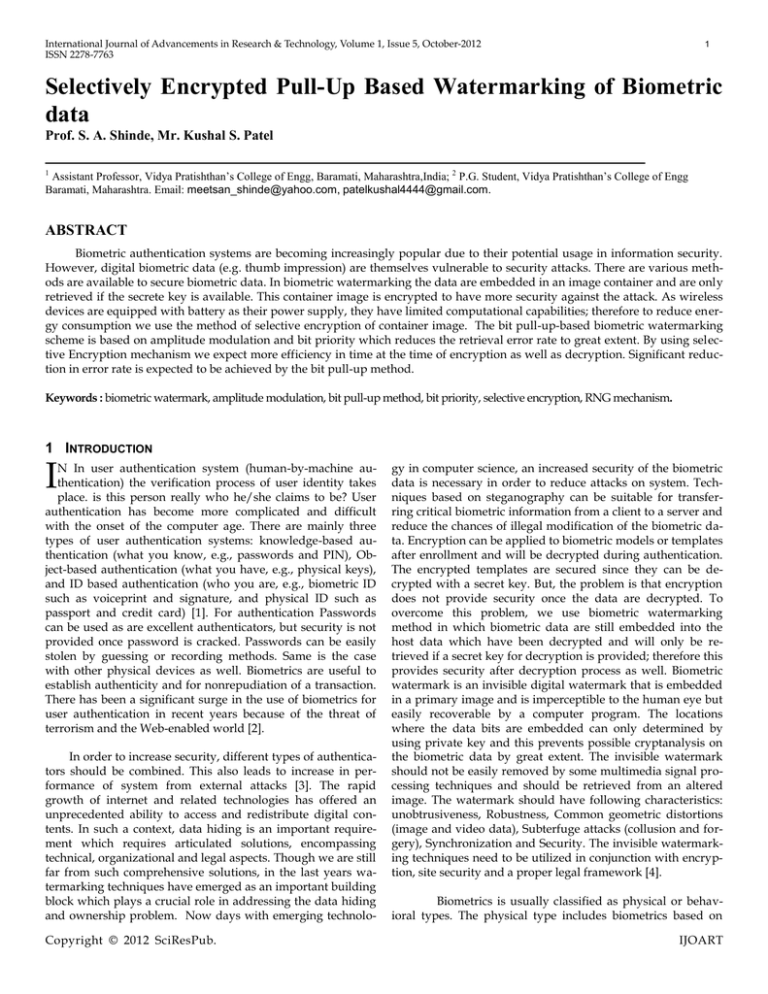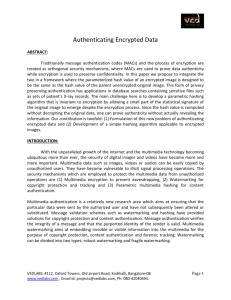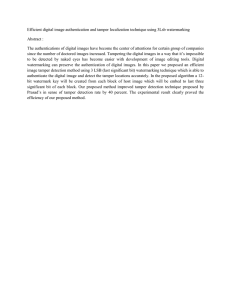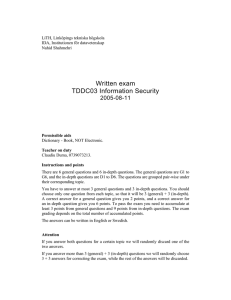Document 14671201
advertisement

International Journal of Advancements in Research & Technology, Volume 1, Issue 5, October-2012
ISSN 2278-7763
1
Selectively Encrypted Pull-Up Based Watermarking of Biometric
data
Prof. S. A. Shinde, Mr. Kushal S. Patel
1
Assistant Professor, Vidya Pratishthan’s College of Engg, Baramati, Maharashtra,India; 2 P.G. Student, Vidya Pratishthan’s College of Engg
Baramati, Maharashtra. Email: meetsan_shinde@yahoo.com, patelkushal4444@gmail.com.
ABSTRACT
Biometric authentication systems are becoming increasingly popular due to their potential usage in information security.
However, digital biometric data (e.g. thumb impression) are themselves vulnerable to security attacks. There are various methods are available to secure biometric data. In biometric watermarking the data are embedded in an image container and are only
retrieved if the secrete key is available. This container image is encrypted to have more security against the attack. As wireless
devices are equipped with battery as their power supply, they have limited computational capabilities; therefore to reduce energy consumption we use the method of selective encryption of container image. The bit pull-up-based biometric watermarking
scheme is based on amplitude modulation and bit priority which reduces the retrieval error rate to great extent. By using selective Encryption mechanism we expect more efficiency in time at the time of encryption as well as decryption. Significant reduction in error rate is expected to be achieved by the bit pull-up method.
Keywords : biometric watermark, amplitude modulation, bit pull-up method, bit priority, selective encryption, RNG mechanism.
1 INTRODUCTION
I
N In user authentication system (human-by-machine authentication) the verification process of user identity takes
place. is this person really who he/she claims to be? User
authentication has become more complicated and difficult
with the onset of the computer age. There are mainly three
types of user authentication systems: knowledge-based authentication (what you know, e.g., passwords and PIN), Object-based authentication (what you have, e.g., physical keys),
and ID based authentication (who you are, e.g., biometric ID
such as voiceprint and signature, and physical ID such as
passport and credit card) [1]. For authentication Passwords
can be used as are excellent authenticators, but security is not
provided once password is cracked. Passwords can be easily
stolen by guessing or recording methods. Same is the case
with other physical devices as well. Biometrics are useful to
establish authenticity and for nonrepudiation of a transaction.
There has been a significant surge in the use of biometrics for
user authentication in recent years because of the threat of
terrorism and the Web-enabled world [2].
In order to increase security, different types of authenticators should be combined. This also leads to increase in performance of system from external attacks [3]. The rapid
growth of internet and related technologies has offered an
unprecedented ability to access and redistribute digital contents. In such a context, data hiding is an important requirement which requires articulated solutions, encompassing
technical, organizational and legal aspects. Though we are still
far from such comprehensive solutions, in the last years watermarking techniques have emerged as an important building
block which plays a crucial role in addressing the data hiding
and ownership problem. Now days with emerging technoloCopyright © 2012 SciResPub.
gy in computer science, an increased security of the biometric
data is necessary in order to reduce attacks on system. Techniques based on steganography can be suitable for transferring critical biometric information from a client to a server and
reduce the chances of illegal modification of the biometric data. Encryption can be applied to biometric models or templates
after enrollment and will be decrypted during authentication.
The encrypted templates are secured since they can be decrypted with a secret key. But, the problem is that encryption
does not provide security once the data are decrypted. To
overcome this problem, we use biometric watermarking
method in which biometric data are still embedded into the
host data which have been decrypted and will only be retrieved if a secret key for decryption is provided; therefore this
provides security after decryption process as well. Biometric
watermark is an invisible digital watermark that is embedded
in a primary image and is imperceptible to the human eye but
easily recoverable by a computer program. The locations
where the data bits are embedded can only determined by
using private key and this prevents possible cryptanalysis on
the biometric data by great extent. The invisible watermark
should not be easily removed by some multimedia signal processing techniques and should be retrieved from an altered
image. The watermark should have following characteristics:
unobtrusiveness, Robustness, Common geometric distortions
(image and video data), Subterfuge attacks (collusion and forgery), Synchronization and Security. The invisible watermarking techniques need to be utilized in conjunction with encryption, site security and a proper legal framework [4].
Biometrics is usually classified as physical or behavioral types. The physical type includes biometrics based on
IJOART
International Journal of Advancements in Research & Technology, Volume 1, Issue 5, October-2012
ISSN 2278-7763
stable body features, such as fingerprint, face, iris, and hand.
The behavioral type includes learned movements such as
handwritten signature, keyboard dynamics (typing), and gait.
However, biometrics can be copied or counterfeited, so they
cannot ensure authenticity or offer a guaranteed defense
against repudiation.
There are various cryptographic techniques are available in the area of information security In symmetric key algorithm, both encryption & decryption uses the same key which
is kept secrete from third party. [5-2]. Some sophisticated algorithms like DES, IDEA, RSA, AES etc. provides much security
of confidential data and used for text & binary data. It is difficult to apply them directly on multimedia data as multimedia
data are often of large size & require real time operation. As
wireless devices are equipped with battery as their power
supply, they have limited computational capabilities; therefore
to reduce energy consumption we use the method of selective
encryption of container image.
An efficient partial encryption algorithm is the potential solution to save power for wireless devices and at the
same time to sufficiently protect the data. To achieve the encryption algorithm to cipher the selected part of the image
container. This scheme use symmetric key algorithm with
RNG mechanism.
2 BIOMETRIC WATERMARKING
In Biometric watermarking, image is viewed as combination of three channels (i.e. R,G,B). The blue channel is
used to embed information. Blue channel is used because blue
color has less sensitive to human eyes comparing with the red
or the green ones, so better invisibility can be achieved. Extraction of bits will be handled by using the neighbor approximation technique in which average of all eight neighbors is considered. This method is used for invisible watermarking. In
biometric watermarking, biometrics such as fingerprint, voice,
and iris data will be converted to a bit sequence and then be
embedded to a primary image. Consider the following example, where the bit sequence to be embedded is 0010 0001 and
two watermarking techniques are used. After encoding and
decoding by the first watermarking technique, the retrieved
bit sequence is 0100 0001 with an error on the second and third
bits. Using the second technique, the retrieved bit sequence is
0010 0010 with an error on the last two bits. If the number of
wrong bits is regarded as error, we can see that the two watermarking techniques provide the same error (two wrong
bits). However, if these embedded bit sequences are converted
to unsigned 8-bit integers, and the difference between two
integers is considered as an error, then the first watermarking
method provides higher error than the second one does (the
above sequences 0010 0001, 0100 0001, and 0010 0010 are corresponding to 33, 65, and 34, respectively.) From the above
example, we can see that bits in different positions in a bit sequence will have different priorities for numerical information. The current amplitude modulation method for color
Copyright © 2012 SciResPub.
2
images [4, 6] does not take into account this bit priority problem.
In Bit Pull-up based digital watermarking method
based on amplitude modulation and priority, high priority
bits should be embedded at good positions in the primary image. This achieves low error rate at extraction process. Experimental results show a significant error reduction for this bit
pull-up-based method comparing with the other digital watermarking method based on amplitude modulation.
3 AMPLITUDE MODULATION AND BIT PULL-UP
BASED DIGITAL WATERMARKING
Let I(m, n) be a color image of size m * n. If the RGB
color system is used, then
I(m, n) = {R(m, n), G(m, n), B(m, n)}.
Where
R(m,n) I
G(m,n) I
B(m,n) I
Let S = (s1, s2, …, sk) be the bit sequence of size k to
be embedded in the image I. So after embedding data, set I’(m,
n) = {R’(m, n), G’(m, n), B’(m, n)}. The amplitude modulationbased digital watermarking method embeds bits by modifying
the blue channel in the color image I. In order to reduce error
rate at retrieval end, each bit in S will be embedded d times at
different positions in the image I. Therefore
I’(m, n) = {R(m, n), G(m, n), B’(m, n)}
[
blue channel is changed]
Encoding Process: A pseudo-random position sequence p = (p1,
p2, …, pd*k) , where p(t–1)*d+h = (i, j) representing row and
column indices at which bit st is embedded the h-th time, is
chosen to embed the bit sequence S. The sequence p is randomly generated by a pseudo-random generator based on a
given secret key K, which is used as a seed to the generator.
The sequence of pseudo-random positions can be calculated
by Maclaurin series method. Maclaurin series is a representation
of a function as an infinite sum of terms that are calculated
from the values of the function's derivatives at a single point.
The error in this approximation is no more than
|x|9/9!. In particular, for −1 < x < 1, the error is less than
0.000003. This Maclaurin series is used here to reduce complexity of sequence generator. As Maclaurin series expansion
is very much easy with parallel computing techniques, it is
very much easy to compute sequence in average time complexity of O(n/4). It can be seen that if the difference between
B’’i,j and B’i,j is low, then the retrieved bit is good. In this proposed method we are calculating Piwett operator to determining good positions in the container image.
Pewitt operator which calculates the gradient in a two
dimensional image to determine good positions. The lower the
IJOART
International Journal of Advancements in Research & Technology, Volume 1, Issue 5, October-2012
ISSN 2278-7763
3
gradient at a position is, the better this position is. Gradient
ranges starting from 0 if the image contains no variations in
pixels, if variations are less the Piwett value tends to zero and
vice versa.
This Piwett function can be calculated by
As R = R’, we have G’ i,j = Gi,j at all position (i, j) calculated.
Therefore the sequence p after rearranging is the same in both
the encoder and decoder processes.
The position sequence p will be rearranged according
to the increase of gradient. It is observed that the probability
to retrieve embedded bit at position whose value of gradient
factor is greater than 23 is less than 0.4924. Therefore we are
discarding those positions from list. By discarding average
quality and bad quality positions we get an array of positions
which contains all good positions. We are now embedding
data bit at this location. As the position is good bit is high prior. All the positions are good means all the bits are high priority bits. After this process the bits will be embedded sequentially.
The t-th bit in the bit sequence S will be embedded in the
blue channel of the image I at d positions p(t–1)*d+h , …, pt*d
according to the following equation
If the original value Bi,j is given, we can determine the value of the embedded bit st by checking the difference δ between the retrieved value and the original value of the
pixel being taken δi,j = B’i,j – Bi,j. The sign of the difference determines the value of the embedded bit. However, unfortunately, we do not have Bi,j at decoding process, so we try
to estimate it, denoted as B’’i,j, by using linear combination
approximation of neighbor pixels. If the 8 neighbor pixels of
the pixel (i, j) are considered, the value B’’i,j is calculated as
follows
and the approximated difference now is calculated as
The single bit st is embedded at d positions p(t–1)*d+1 , …,
pt*d, therefore we use the arithmetic average method to calculate the value δt
B’i,j = Bi,j + stqLi,j
where Li,j is luminance at the position (i, j) and can be
calculated as follows
Li,j = 0.299Ri,j + 0.587Gi,j +0.144Bi,j
The sign of δt is the estimated bit s’t of the embedded bit st.
The larger the absolute value of
is, the higher confidence
of the estimation i.
and q is a tradeoff between robustness and invisibility.
Decoding Process: Based on the secret key function K, the sequence p(t–1)*d+h , … , pt*d is regenerated as shown in the
encoding process. However, the gradient at each position
needs to be calculated and depending on these gradient values, the sequence p will be rearranged.
Copyright © 2012 SciResPub.
Algorithm ( Embedding data) :
Data elements : Sequence[ ], I : Image, I’ : image, Piwett[ ] , n :
no of bits in input data. s[ ] : bit stream, L[ ] : Luminance factor,
x,n,I,d : iterators.
Step 1: Convert image input to bit sequence
Create bit_seq(image).
Step 2 : Generate sequence by secrete key function.
for(x ← 1;x<12*d;x+=12)
for(n ← 1;n<4;n++) // Error factor is 4,
sign ← -1*sign;
denom ← 1;
IJOART
International Journal of Advancements in Research & Technology, Volume 1, Issue 5, October-2012
ISSN 2278-7763
for ( i= 1; i<=((2*n)+1); i++)
denom ← denom* i;
for ( i ← 1; i<=((2*n)+1); i++)
multiplier ← multiplier *x;
seq[pos]←sign*(multiplier/denom);
seq[pos]←seq[pos]mod
size_of_biometric_data;
pos ←pos+1;
end for;
end for;
4
all data contents; only the segments of data are encrypted. The
data should be segmented in a standard pattern which involves sufficient uncertainty. The more confusion is involved,
the security will be more and more effective is the cryptosystem. In Multimedia systems, tremendous audio and video
data need to be transferred securely .Real time transmission
has very much importance in the field of multimedia transmission. To encrypt whole multimedia data large time and
computational power is required. This may affect on the timely transmission of data. In such circumstances, the design of a
selective encryption algorithm with less processing time but
with relatively high security level is extremely significant.
Step 3 : Operate Piwett function.
for seq[0] to seq[d*n] do
This algorithm aims to involve sufficient confusion into the
encryption process, while providing satisfactory security of
the message. In order to select the message randomly it uses
the concept of Random Number Generation [8]
end for
Step 4: Discarding bad positions
for i=seq[0] to seq[d*n] do
if ( pewitt[i]< Max_Threshold ) then
discard seq[i] from list;
Step 5: Sort seq[ ] by gradient values
sort( seq[ ],pewitt[ ]);
Step 6: Embed bits at Good positions
for t=1 to n do
for i=1 to d do
p=(t–1)*d+i ;
B’=B[ seq[p] ]+ St q L[p];
I’ [B[ seq [p] ] ] = B’ ;
end for;
end for;
Step 5: End;
Algorithm for data extraction is same as embedding process, only we are collecting data bits in step 6.
Step 6: Extract bits from Good positions
for i=1 to d do
end for;
This partial encryption algorithm which uses the advantages of randomization method aiming to obtain sufficient
uncertainties in the selection of the bit positions of a multimedia message. At the time of sending the message, message is
converted into binary format and then random positions are
determined. The data at the position of random positions will
be encrypted. After that this encrypted segments are send
through the communication channel by concatenating them
with remaining bits of data at appropriate positions.
Algorithm (Encryption):
Data elements : Length : length of image, Sequence[ ], I : Image, I’
: image , Ki :Symmetric key, n : no of bits in input data. s[ ] : bit
stream, SendData[] , x,n,I,d : iterators.
Step1: Length= No_of_bytes(Image);
Step 2: no_of_positions = (70 * Length/100)+C;
// The generated bit positions should be higher
than the 70% of the determined Length.
Sequence = Genete_random();
Step 3: for i=1to Length do
If(i= Sequence[i])
Inparam=I[Sequence[i]];
SendData= SendData+ Encrypt(Inparam ,Ki);
Else
SendData= SendData+ I[Sequence[i]];
end for;
Step 4 : I’= SetImage(SendData[]);
3 SELECTIVE ENCRYPTION ALGORITHM
Step 5 : end;
In selective encryption is just to encrypt a certain portion of
messages with less consumption of energy and time but at the
same time data should be encrypted in order to secure data
sufficiently [5]. In this algorithm need not required to encrypt
Algorithm Decryption:
Copyright © 2012 SciResPub.
Data elements : Length : length of image, Sequence[ ], I : Image, I’
: image , Ki :Symmetric key, n : no of bits in input data. s[ ] : bit
IJOART
International Journal of Advancements in Research & Technology, Volume 1, Issue 5, October-2012
ISSN 2278-7763
stream, RecvData[] , x,n,I,d : iterators.
Step1: Length= No_of_bytes(Image);
Step 2: no_of_positions = (70 * Length/100)+C;
// The generated bit positions should be higher
than the 70% of the determined Length.
Sequence = Genete_random();
Step 3: for i=1to Length do
If(i= Sequence[i])
Inparam=I’[Sequence[i]];
RecvData= RecvData+ Decrypt(Inparam ,Ki);
Else
RecvData= RecvData+ I[Sequence[i]];
5
Using Amplitude Modulation”, Journal of Electronic Imaging, vol. 7, no. 2,
pp. 326 – 332, 1998 194
[8] N. M. Thamrin, G. Witjaksono, A. Nuruddin, Eds.,“An Enhanced Hardware-based Hybrid Random Number Generator for Cryptosystem”, Proceedings of International Conference on Information Management and Engineering, pp. 152–156, 2009.
[9] S.P. Mohanty, K.R. Ramakrishnan, M.S. Kankanhalli, “A DCT domain visible
watermarking technique for images”, in Proceedings of Multimedia and Expo IEEE International Conference, vol. 2, pp. 1029 – 1032, 2000
[10] I.J. Cox et al., “Secure Spread Spectrum Watermarking for Multimedia”, IEEE
Trans. on Image Processing, vol. 6, no. 12, pp. 1673 – 1687, 1997
[11] R. G. Wolfgang, and E. J. Delp, “A Watermark for Digital Images”, Proc. IEEE
Intl. Conf. on Image Processing, ICIP-96, vol. 3, pp. 219 – 222, 1996
[12] W. Zhu et al., “Multiresolution Watermarking for Images and Video: A Unified Approach”, Proc. IEEE International Conf. on Image Processing, vol. 1,
pp. 465 – 468, 1998
end for;
Step 4 : I’= SetImage(RecvData[]);
Step 5 : end;
[13] P. Loo, N. Kingsbury, “Watermark detection based on the properties of error
control codes”, IEE Proceedings Vision, Image and Signal Processing, vol. 150,
no. 2, pp. 115 – 121, 2003
4 CONCLUSION
We have proposed a new biometric watermarking
method based on amplitude modulation and bit priority level
using Pull-Up method. While inheriting security characteristics such as anti-attack from the original method, the proposed
method is very useful in biometrics applications, where numeric feature or model values of fingerprint, voice, or iris need
to be embedded to an image. The Security is based on two
keys which are very hard as such to break. Invisible Partial
encryption provides more security with less computational
complexity and power consumption. The proposed method
has been evaluated and compared with the current digital watermarking method based on amplitude modulation. Since the
errors are nearly zero in the proposed method, no changes
have been affected to biometric authentication systems.
5 REFERENCES
[1]
[2]
[3]
[4]
[5]
[6]
[7]
Tuan Hoang, Dat Tran, Dharmendra Sharma “Bit Priority-Based Biometric
Watermarking”, University of Canberra, Proceedings of the IEEE, pp. 191-195,
2008.
L. O’Gorman. Comparing Passwords, Tokens, and Biometrics for User Authentication. Proceedings of the IEEE, vol. 91, no. 12, pp. 2021-2040, 2003
R.M. Bolle, J. Connell, S. Pankanti, N. K. Ratha, and A. W. Senior. Biometrics
101. IBM Research Report, IBM T. J. Hawthorne, New York, 2002
F. Bao, R. H. Deng,“Light-Weight Encryption Schemes for Multimedia Data
and High-Speed Networks”, Proceedings of IEEE Global Telecommunications Conference, pp. 271–350, 2007.
Yonglin Ren, A. Boukerche, L. okdad,“Performance Analysis of a Selective
Encryption Algorithm for WirelessAd-Hoc Networks”, Proceedings of IEEE
Wireless communications and networking conference, pp. 1038- 1043,2011.
M. Aikawa, K. Takaragi, Eds.,“A Lightweight Encryption Method Suitable
for Copyright Protection”, IEEE Transactions on Consumer Electronics, Vol.
44, pp. 902–910, 1998.
M. Kutter, F. Jordan, and F. Bossen, “Digital Watermarking of Color Images
Copyright © 2012 SciResPub.
IJOART




